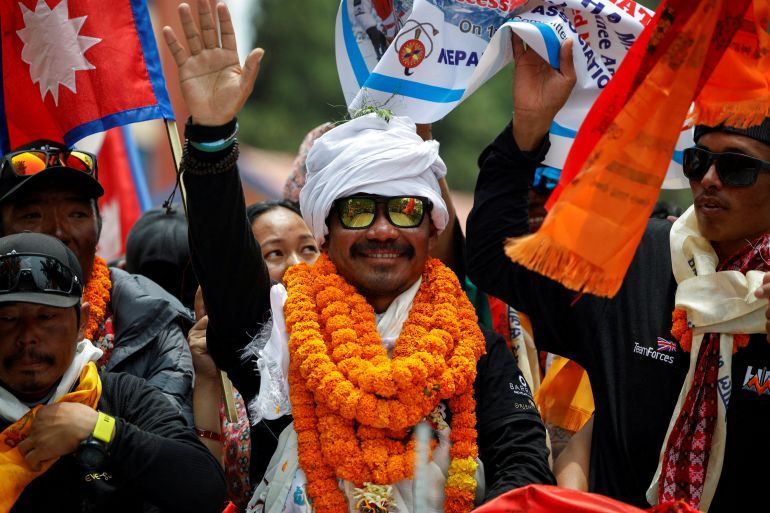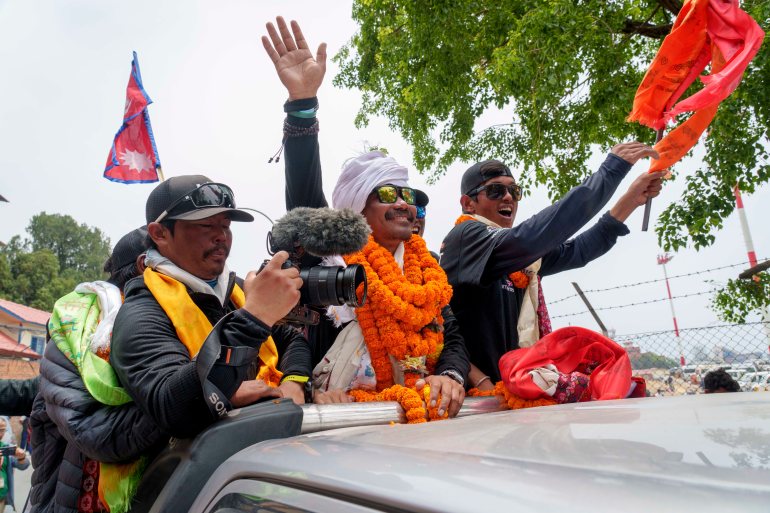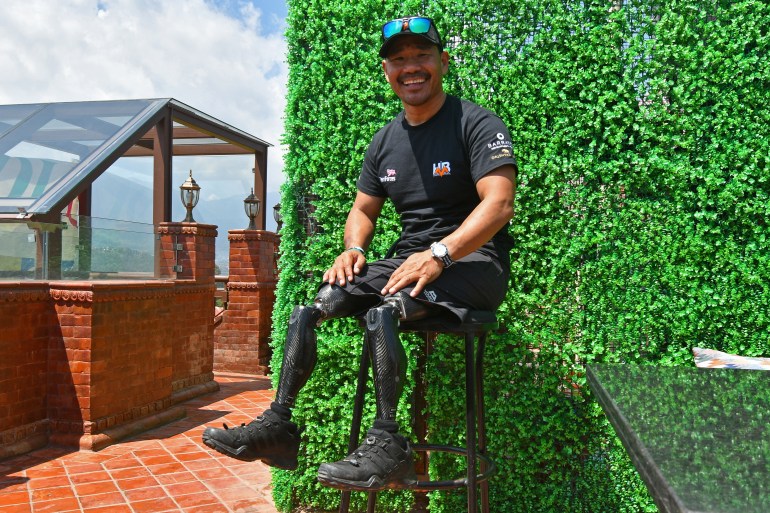First double amputee to climb Everest says will work for disabled
Hari Budha Magar, a former Gorkha soldier who served the British army in Afghanistan, now wants to help people with disabilities.

The first double above-the-knee amputee to climb Mount Everest has returned from the expedition, pledging to dedicate the rest of his life to helping people with disabilities.
Hari Budha Magar, a former Gurkha soldier who was almost killed serving with the British army in Afghanistan, reached the peak of the world’s highest mountain on Sunday. He climbed down on Tuesday.
Keep reading
list of 4 itemsNepal issues record 454 Mount Everest climbing permits
Nepal says tourists trekking in Himalayas must hire local guides
Coping with climate change on Mt Everest
“My main aim for the rest of my lifetime is going to be working to bring awareness about disability,” Magar, 43, said on his return to Kathmandu, Nepal’s capital.
As a soldier in a Gurkha regiment in the British army, Magar lost both his legs in Afghanistan when he accidentally stepped on an improvised explosive device in 2010.
‘For the sake of my son’
Hundreds of supporters and officials, including Nepal’s tourism minister, greeted him at Kathmandu’s airport and offered him garlands. He was taken from the airport in an open truck decorated with flowers and waved at people along the way.

“We all have our own weaknesses and disabilities, but instead of the weaknesses, we should be focusing on our strength, and only then we can all lead a better and meaningful life,” Magar, a resident of Canterbury in the United Kingdom, said.
He said the climb up the 8,849-metre (29,032-foot) mountain was not easy and he thought several times about quitting because of his family.
“I had made the promise that I will have to return for the sake of my son,” he said.
On the way to the summit, he ran out of oxygen in the tank he was carrying.
“This was the first time I experienced what it is to be deprived of oxygen. I had the tingling sensation, my hands and feet were cold and I was gasping for breath,” he said.
He was able to get more oxygen from his climbing partners, but then battled with bad weather as he approached the summit, which he reached late in the afternoon because of his slow pace.
Most climbers try to reach the top in the morning because conditions become dangerous later in the day.
He said he saw rescuers pulling the bodies of two dead climbers along the way.
‘Goal is to change perceptions’
After the successful mission, “I hugged all the Sherpas and cried like a baby, I was so happy”, Magar said in a video released by his press office.
“My lifetime goal is to change the perceptions people have of disability. My life changed in a blink of an eye. But whatever happens, you can still lead a fulfilling life,” he said.
“If a double above-knee amputee can climb Everest, you can climb whatever mountain you face, as long as you are disciplined, work hard and put everything into it.”

Mount Everest has been climbed by more than 11,000 people, including those with disabilities such as blindness and below-the-knee amputees.
Two below-the-knee amputees have reached the peak in the past – New Zealander Mark Inglis in 2006 and China’s Xia Boyu in 2018.
Magar was born in a remote mountain village in Nepal and was later recruited by the British army as a Gurkha.
Hundreds of Nepalese youths are recruited every year to work as Gurkha soldiers, known for their fighting skills and bravery.
In addition to dealing with his disabilities, Magar also had to battle legal issues because Nepal’s government had banned disabled people from climbing high mountains.
A case was filed in the Supreme Court, which overturned the ban, allowing Magar to continue his plan to climb Everest. During the coronavirus pandemic, the government halted mountaineering, further delaying Magar’s plan.
Nepal is home to eight of the world’s 10 highest peaks and welcomes hundreds of adventurers each spring, when temperatures are mild and often treacherous Himalayan winds are typically calm.
Authorities have issued 478 permits to foreign climbers this year, with each paying an $11,000 fee. Since most will need a guide, more than 900 people – a record – were expected to try to summit during the season, which runs until early June.
On Tuesday, 53-year-old Nepali Sherpa Kami Rita reached the summit of Mount Everest for a record 28th time, completing his second ascent in just a week.
At least 11 climbers have lost their lives this year while attempting to climb Everest.